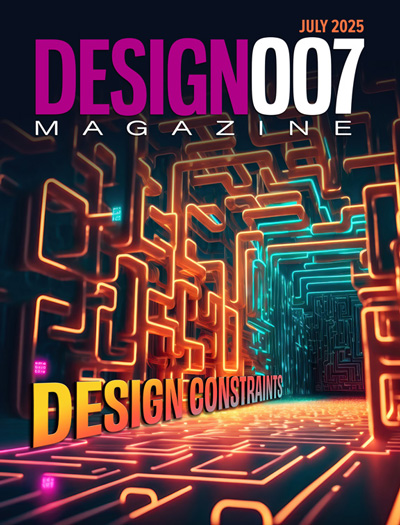-

- News
- Books
Featured Books
- design007 Magazine
Latest Issues
Current Issue
Signal Integrity
If you don’t have signal integrity problems now, you will eventually. This month, our expert contributors share a variety of SI techniques that can help designers avoid ground bounce, crosstalk, parasitic issues, and much more.

Proper Floor Planning
Floor planning decisions can make or break performance, manufacturability, and timelines. This month’s contributors weigh in with their best practices for proper floor planning and specific strategies to get it right.

Showing Some Constraint
A strong design constraint strategy carefully balances a wide range of electrical and manufacturing trade-offs. This month, we explore the key requirements, common challenges, and best practices behind building an effective constraint strategy.
- Articles
- Columns
- Links
- Media kit
||| MENU - design007 Magazine
Selling PCB Design Services in a First-World Country
February 17, 2017 | Lance Olive, Better Boards Inc.Estimated reading time: 2 minutes
Quality PCB design is an evolving breed of services in first world countries. As North American and European companies squeeze the skilled designers out of their own workforce, pushing more of the work into Eastern Europe and Asia, those who remain with the skills either opt for retirement, career change or consolidation.
As the business operations manager for Better Boards Inc., I see our company at the focal point for consolidation: a gathering of skilled board designers to create a center of excellence. It is at this point that we have the critical problem facing a PCB design services company: How do we effectively sell these services back to the companies that cast off their own skilled employees? How do we sell PCB design services into small companies that can barely afford the one overworked electrical engineer that they hired last year?
In addressing these key questions, we evaluate the three key challenges and embrace the three tantalizing opportunities. Doing this well gets our foot in the door and positions us to sell these services in the hardware design teams that would prefer to be designing circuits rather than layouts.
The Challenges
The first challenge is the price competition from both overseas labor and the designer working from home. PCB design layout service rates in Europe and North America remain relatively high for companies who know the value of the skill that designers bring. Meanwhile, small companies in the Czech Republic, Poland, India, Russia, Malaysia, the Philippines, Vietnam and China can offer layout services for about half of those domestically. Likewise, the designer in his bonus room has very low overhead (sometimes quite literally, thanks to knee walls), and can often undercut the hourly rates of a proper services company.
The second challenge is that of being multilingual in CAD tools. Between the customers demanding that we use Cadence Allegro, Altium, Mentor Graphics Xpedition, Eagle, KiCAD or many other cheap and free tools, it’s enough to drive a designer mad. No person can reasonably support all of those. To support multiple customers means to support multiple tools. This is difficult to achieve with just one or two designers, since most professional designers are great at one tool, fair with another, and merely aware of the rest. Being successful means establishing a team of designers with varying skillsets—a matrix of designers with a mix of tool knowledge that can support any type of RFQ that comes in.
To read this entire article, which appeared in the January 2017 issue of The Printed Circuit Design Magazine, click here.
Testimonial
"In a year when every marketing dollar mattered, I chose to keep I-Connect007 in our 2025 plan. Their commitment to high-quality, insightful content aligns with Koh Young’s values and helps readers navigate a changing industry. "
Brent Fischthal - Koh YoungSuggested Items
Staying on Top of Signal Integrity Challenges
09/16/2025 | Andy Shaughnessy, Design007 MagazineOver the years, Kris Moyer has taught a variety of advanced PCB design classes, both online IPC courses and in-person classes at California State University-Sacramento, where he earned his degrees in electrical engineering. Much of his advanced curriculum focuses on signal integrity, so we asked Kris to discuss the trends he’s seeing in signal integrity today, the SI challenges facing PCB designers, and his go-to techniques for controlling or completely eliminating SI problems.
ASM Technologies Limited signs MoU with the Guidance, Government of Tamilnadu to Expand Design-Led Manufacturing capabilities for ESDM
09/15/2025 | ASM TechnologiesASM Technologies Limited, a pioneer in Design- Led Manufacturing in the semiconductor and automotive industries, announced signing of Memorandum of Understanding (MoU) with the Guidance, Government of Tamilnadu whereby it will invest Rs. 250 crores in the state to expand its ESDM related Design-Led Manufacturing and precision engineering capacity. ASM Technologies will acquire 5 acres of land from the Government of Tamilnadu to set up a state-of-the-art design facility in Tamil Nadu's growing technology manufacturing ecosystem, providing a strong strategic advantage and long-term benefits for ASM.
Variosystems Strengthens North American Presence with Southlake Relaunch 2025
09/15/2025 | VariosystemsVariosystems celebrated the relaunch of its U.S. facility in Southlake, Texas. After months of redesign and reorganization, the opening marked more than just the return to a modernized production site—it was a moment to reconnect with our teams, partners, and the local community.
Deca, Silicon Storage Technology Announce Strategic Collaboration to Enable NVM Chiplet Solutions
09/11/2025 | Microchip Technology Inc.As traditional monolithic chip designs grow in complexity and increase in cost, the interest and adoption of chiplet technology in the semiconductor industry also increases.
I-Connect007 Launches New Podcast Series on Ultra High Density Interconnect (UHDI)
09/10/2025 | I-Connect007I-Connect007 is excited to announce the debut of its latest podcast series, which shines a spotlight on one of the most important emerging innovations in electronics manufacturing: Ultra-High-Density Interconnect (UHDI). The series kicks off with Episode One, “Ultra HDI: What does it mean to people? Why would they want it?” Host Nolan Johnson is joined by guest expert John Johnson, Director of Quality and Advanced Technology at American Standard Circuits (ASC).


